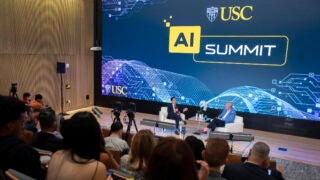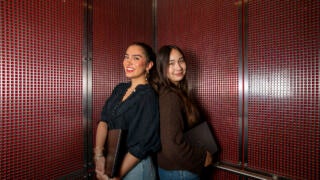Meeting of the Minds
Right Brain, this is Left Brain. Scott Fraser’s happy to make the introduction.
Behold the all-powerful cappuccino machine.
Drawn from labs and laptops, the scientists on Scott Fraser’s team follow the aroma of brewing beans. They gather around the coffeemaker for a jolt of caffeine, but they often find inspiration and unexpected solutions as well.
USC recruited Fraser from Caltech to make creative sparks fly among USC academics. He aims to bring together physicists and engineers, computational biologists and visual artists, chemists and mathematicians.
“You could almost hyphenate anything to anything here at USC and come up with some new opportunities,” says Fraser, USC’s new director of science initiatives within the USC Office of the Provost. He also holds a joint faculty appointment in the USC Dornsife College of Letters, Arts and Sciences’ biology department, USC Viterbi School of Engineering, Keck School of Medicine of USC and Children’s Hospital Los Angeles.
Fraser has melded great minds before. His cappuccino strategy comes from his two decades at Caltech, where he directed the Biological imaging Center and conducted influential research into embryonic development. He set up an industrial coffeemaker in a central location and let the unplanned interactions work their magic.
“People would sit down and bellyache about the experiment that just failed or share the triumph they just had in the lab,” he says. “More times than not, the next person at the table would say, ‘Well, why is that a triumph?’ or ‘Wait, I know how to solve that problem.’ We generated companies, research projects and dozens of patents from people sitting down and finding out where the solutions could be brought in from another field.”
In his new post, Fraser will be integral to pushing USC’s progress as a scientific leader, says michael Quick, USC executive vice provost.
“We need to engage all of our science faculty in strategic planning for the large, interdisciplinary science initiatives that will be the hallmark of 21st-century science,” Quick says. Fraser will work closely with faculty and deans across USC, as well as others in the Office of the Provost, to spur innovation.
As Fraser settles in to the fourth floor of Irani Hall—unpacking boxes, furnishing offices and outfitting his lab—his schedule is still far from routine. Most days, he says, involve “some part of the day designing or interpreting experiments, and some part of the day networking with this amazing variety of talents on campus.”
He especially enjoys the sense of community that unites the four floors of Irani. A fellow biologist once bumped into him in the hallway and yelled, “I love this building!”
Community and collaboration have contributed a great deal to Fraser’s own research.
To develop the microscope technology he needed to study rapidly developing cells, Fraser was able to “steal”—his term for interdisciplinary appropriation—from the findings of engineers working on satellites. He sees similar potential for crossover research at USC.
“I walk around campus and I see four or five ways we could interface between computational biology and the school of cinema, let alone social sciences, let alone the business school,” Fraser says. “We’re really trying to orchestrate a whole community of scholars around a set of big problems.”
When Fraser describes moments of genius that result from random interactions, you can see why his coffee-klatch plan is key: “The whole idea is to create an environment where accidents happen, where lightning strikes. Lightning isn’t always going to strike in the same place or between the same people, so we need to make sure we’re making a lot of opportunities.”
Fraser relishes his new challenge and believes that USC is a perfect move for him—there’s something empowering, he says, about being at a school that is large enough to think about changing the way things happen and small enough to actually imagine changing them.
“USC has been extremely venturesome in how it’s invented and reinvented itself and continues to make its programs more expansive and more powerful,” Fraser says. It’s also fertile ground for collaboration. USC already has numerous cross-disciplinary faculty members, including Andrew McMahon, a new stem cell scientist who is forging relationships with engineers and others at the University Park Campus, and Mark Humayun, a physician who’s also a biomedical engineer.
The new position is no surprise to those around Fraser. Rusty Lansford, a senior research scientist, describes Fraser as “a scientific polymath. He is wickedly smart, highly imaginative and able to connect dots from many scientific arenas—all of which makes him a very creative person, someone ideal for developing new initiatives.”
Fraser’s pleasure with his new role at USC is palpable. “There aren’t too many jobs where you wake up in the morning and think about all the cool things that could happen that day,” he says.
He’s planning to place the new cappuccino maker in his Irani Hall office, which has a view of the Hollywood sign, to get the conversation going. “Oh, you could probably do it with margaritas as well,” he offers, “but it would be a much shorter day.”



